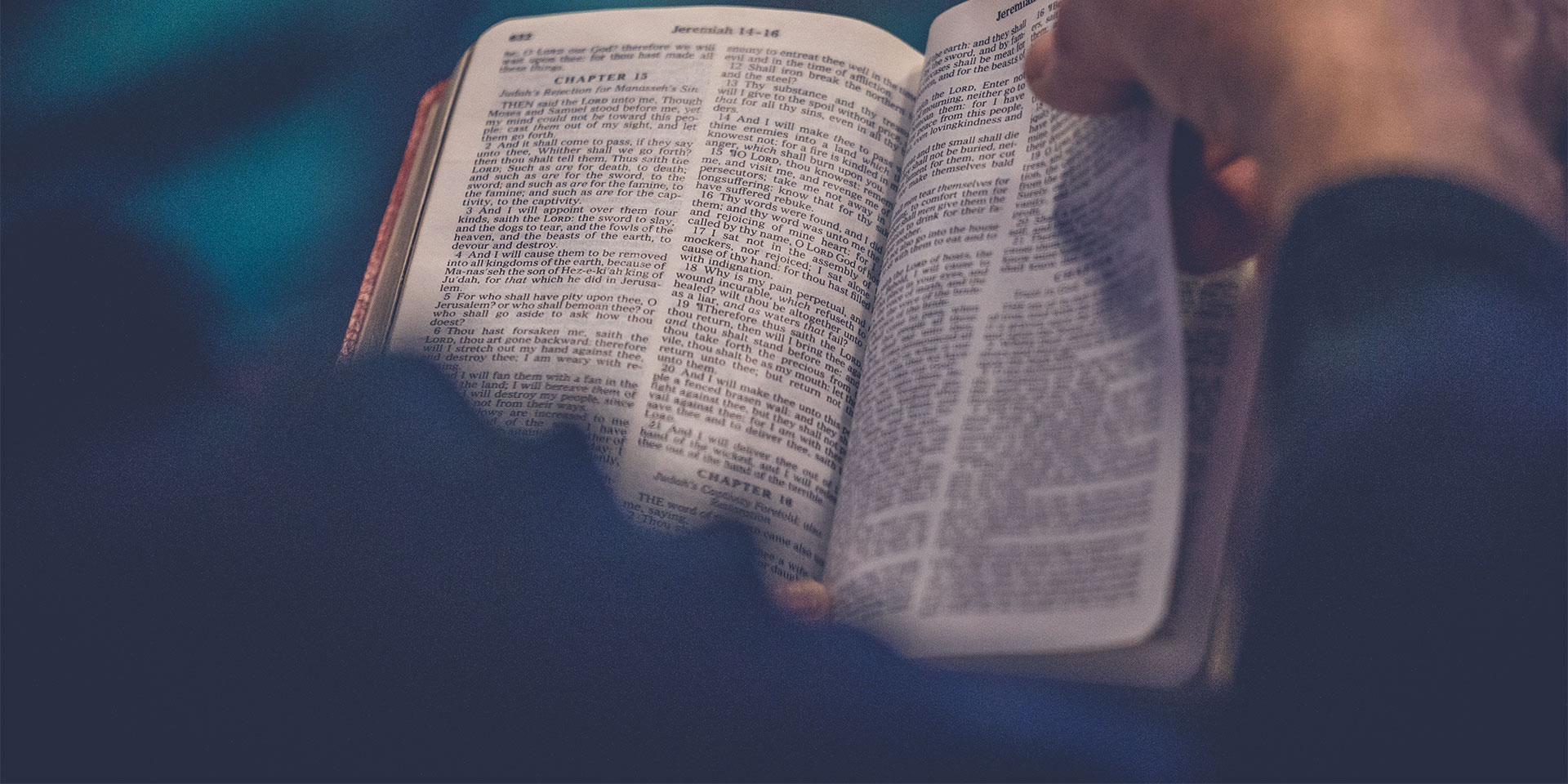More than a collection of information, beyond its role as a guide, the Bible is where we have a redemptive encounter with the One who holds the keys to eternal life.
It was one of those days when I wandered for an hour or more, with a backpack on my back and my favourite dog frolicking ahead or behind me, through places that seem unpromising but are full of stories.
The summer had not yet come over the meadows and vineyards on the hills, but they had blossomed as they knew best, and I breathed in their beauty, following the line of the river that was flowing among willows. That’s how I found myself at the edge of a village whose alleys I had never trodden. People were cleaning the patches of grass in front of their gates or working in their yards—and especially inside the houses, it seemed, because the village looked asleep, although it was well past the waking hour.
Halfway there, as I began to notice the order and good taste in the awkwardly fenced hidden yards, I saw it. It was one of those houses that I would have barged into as soon as I spotted it, were it not for decency and the inherent reluctance to engage with strangers. I took in the scene: the woodwork painted in light green, small windows, and milk-white curtains, a roof bowing under the arch of time, an inviting porch, and a plump cat sleeping on the doorstep between two pots of unusual flowers for our region. It was the first time I had seen their sword-like leaves, from which clusters of bright pink flowers sprouted. As I studied them, a childhood name for a flower started buzzing in my mind, from the novels of I. A. Bassarabescu: oleander. I couldn’t remember ever seeing an oleander, and yet I had the strange certainty that the flowers on the porch of the charming little house couldn’t be called anything else.
“I just have to ask the owners to dispel any doubt,” I told my fellow traveller, adding in the same breath that it would be great if they invited me inside. However, there was no sign of a soul, so we continued, with the dog sniffing at strange gates and my other wandering companion bewildered by my sudden burst of sociability. Later, we retraced our steps because I still hoped to exchange a few words with the owners of the charming little house, but little did I know that things would get even better. I had stopped again in front of the house when an old lady, dressed in black, emerged from a shaded corner of the yard and asked whom I was looking for.
I explained that I wanted to know the name of her unusual flowers. They were oleanders, she confirmed. After a two-second pause, she asked if I would like a cutting from her flowers. While I was contemplating how to respond to her unexpected offer, another question followed, which took me somewhat by surprise: “Wouldn’t you like to come inside?”
In just two steps, I found myself in the yard and then on the threshold of the house, with a quickness that betrayed my fear of her changing her mind. Inside the little house, time had frozen in the frames of wedding photographs, in bunches of basil hanging from nails in the walls, in wicker baskets filled with walnut kernels, in red apples scattered on the shelves. In a matter of moments, I had returned to my childhood, to the old houses of my village, where stories were never scarce, and pumpkin seeds sizzled on the hot stove.
The surprise, however, came from the kitchen the size of a monk’s cell, where my host slept and where she prayed in the morning, evening, and in the midnight hours when sleep eluded her. She had a small cushion on which she knelt by the wall to utter prayers that she had calligraphed on dictation sheets, and on a narrow table, a large and heavy Bible, as extensive as the dictionary I used to browse through during summer vacations at my grandparents’ house.
She had always read prayer books, the woman told me, but she had always wanted a Bible too. Somehow, by the age of 85, she hadn’t managed to bring one home. She had heard that the priest had some at the church, and fearing that she might miss fulfilling her dream, she bought one after the first service. She placed it on the table and read it halfway, marking each page with a pencil. Winter had been a favourable time to delve into the book, but since the spring had come, she read much less, even though still daily, and she hoped, if allowed, for one more winter to finish it.
That massive Bible had cost the woman 110 dollars, and her pension was not substantial. When I expressed my surprise aloud that she considered it so valuable as to spend money that she clearly did not have, the woman gave me a reproachful, puzzled look, saying, “How could I not buy it? This is the Lord’s Word. It’s the Word of the Lord, dear.”
The unheard word
Even though it often appears among New Year’s resolutions, reading the Bible throughout the year proves to be (for many) an objective as ambitious as it is difficult to achieve.
A 2016 Lifeway Research study revealed that only 20% of Americans had read the entire Bible at least once. And not because they didn’t have it at home; although the Bible is present in 9 out of 10 households, 10% of respondents hadn’t read anything from the Bible, 30% had gone through a few passages or stories, and 13% had read only a few sentences.
When asked to specify why they don’t open their Bibles more often, 27% admitted that they don’t prioritise reading Scripture, 15% mentioned a lack of time, and 13% thought they had read enough. And things took an even worse turn after the pandemic.
“Startling, disheartening, and disruptive”—these are the words researcher John Plake uses to summarise the 2022 report from the American Bible Society. In contrast to 2021, when half of Americans read the Bible at least three or four times a year, only 39% stated the same a year later, marking the sharpest decline recorded so far. Additionally, 10% of respondents read the Bible daily, compared to 14% before the pandemic.
Plake believes that this decline reflects the close connection between reading the Bible and attending church, disrupted during the months of restrictions (and permanently abandoned by some thereafter).
Scott McConnell, executive director of Lifeway Research, adds that for many, the Bible is not a book they read regularly but rather one they consult occasionally, when they or their loved ones face a problem, opening and reading from it randomly.
Isolation from other Christians has a “lethal” effect on Bible reading, Professor Don Whitney says. If people no longer attend church, they are not reminded of the importance of the Bible in their lives. Nor are they taught that it is possible to read it and how to do it: “They’ve never read one book in their life approaching the length of the Bible. (…) You might as well say, ‘Flap your arms and fly to the moon.’ I think we have to show them the doability of it.”
Do we need a plan to read the Bible?
In daily life, we don’t accomplish much without a plan, whether it’s building a house or simply preparing breakfast for the whole family. So why would we think that meeting our spiritual needs happens without scheduling things? This is the question Pastor John Piper asks in an article advocating for careful planning of prayer life and Bible study.
“What the coming year is to bring forth, who can tell?” said Scottish pastor Robert Murray M’Cheyne in a letter to his congregation on December 30, 1845, urging them to study their Bibles to withstand difficult times. He couldn’t have known, but it was the last end of the year he would experience. He would fall ill with typhoid and die in less than three months, just before turning 30.
An average reader can go through the over 1,200 pages of Scripture in approximately 65-75 hours. This means they could read through the entire Bible in less than three months, dedicating an hour a day. Using 12 minutes a day for this purpose, the Bible could be read in a year.
There are numerous Bible reading plans that guide the reader to go through the entire book in three, six, or 12 months (or two years), plans for five or six days a week (to allow catching up on days off in case of falling behind), plans that involve reading multiple books of the Bible in parallel, and so on. Two centuries ago, M’Cheyne himself devised a reading plan (popular to this day) involving two daily sessions that enabled readers to go through the New Testament and the book of Psalms twice and the Old Testament once in a year.
Among the dangers he foresaw in providing a reading plan, M’Cheyne mentioned the degeneration into formalism of the study, the self-righteous feeling created by daily reading, careless reading to meet the quota, and the plan itself becoming a burdensome task.
However, the advantages far outweigh the dangers, the Scottish pastor believed: reading the Bible in a year, saving time (no need to decide every day which passages to read), fostering spiritual conversations in the family, among friends, or in the church when everyone reads according to the same plan, and consequently strengthening Christian bonds among those who read Scripture together.
To establish Bible reading as a habit, a series of practical tips can prove beneficial for beginner readers or those who, despite good intentions, stumble at the book of Leviticus or other seemingly dull passages. These include: setting a dedicated time for Bible reading, anticipating and avoiding moments of distraction, reading sequentially to observe the coherence and beauty of the Word, praying for guidance and understanding of Scripture, and for a hunger for the biblical text.
The lack of meditation on Scripture verses is a significant reason why we miss their message, Spurgeon wrote. The “prince of preachers” also emphasised that genuine understanding of the Word is followed by its application, akin to a patient following a prescription from a doctor. What one understands and lives out can only result in sharing with those who equally need good news as much as your soul does: “When you read a passage of Scripture and have any enjoyment therein, go to your sick neighbour and tell what God has said to you!”
Why prioritise reading the entire Bible?
There are many reasons to read the Bible from cover to cover in a year, and Christian author Melissa Kruger examines some of them.
Each of us has preferred books of the Bible that we would revisit at the expense of others that are more challenging to read. However, the beauty of a plan lies precisely in guiding us through the more intricate books and passages, which we might easily avoid. Reading the Bible sequentially helps us navigate even the more challenging parts, providing an opportunity to ponder on what God wants to teach us and what truth about Him is reflected by those passages.
Moreover, the comprehensive reading of Scripture sketches for us, beyond details, a panoramic perspective—we can place each piece of the puzzle into the broader picture of creation, the fall into sin, redemption, and the renewal of all things.
We open the Scriptures because we desire to see and know God, but it is precisely this organised reading that helps us discover new, unexpected things about Him. It enables us to meditate on different facets of His character and the various ways He works in our lives.
“The Scriptures are to be received as God’s word to us, not written merely, but spoken…. In them He is speaking to us individually, speaking as directly as if we could listen to His voice,” said Ellen White, a well-known Christian writer.
Eternal life can only be obtained through knowing God, and the Word has been given to us precisely to know Him better, He who is the “Everlasting Father” (Isaiah 9:6).
After his first sermon, where he spoke about the origin of evil in the universe, at just 28 years old, Cuban pastor Alexander Noble was arrested and sentenced to 20 years of forced labor (ironically, he served 22 years in the country’s most violent prisons, ultimately released only through negotiations between U.S. presidential candidate Jesse Jackson and President Fidel Castro).
Torture, starvation, forced labor, and long periods of isolation (in cells or “cages” designed to torture inmates minute by minute and break any resistance to “reeducation” programs) failed to discourage Noble in his mission to share the Gospel. In the various prisons where he served his sentence, Noble continually sought ways to procure a Bible. However, it was only a matter of time before the Bible was confiscated during routine searches. So, he made handwritten copies of the portions he read to cellmates, using the backs of cigarette packs and any other scrap of paper available.
Transferred to the prison on Pine Island (a true “Cuban Siberia”[1] where surviving even a single day was a challenge), the pastor found that his reputation had preceded him. He was welcomed by two fellow Christian inmates who, with infinite caution, revealed their treasure. In the rubble of a church that had once stood within the prison, they had found a Bible with tattered pages, preserving a few books. One of the inmates pulled out the precious fragments hidden under his clothes, gently caressing the worn pages and whispering, “This is all we have of God’s Word. Matthew and Luke, bits and pieces of Paul’s epistles and Isaiah through Malachi.”[2]
Noble recounts that tears welled up, but words refused to come. Stripped of everything he owned, physically crushed by the inhumane treatment by the guards, aware that he would face severe consequences for continuing to preach the Gospel, he suddenly felt inexplicably rich.
With so many Bibles in our homes (and dozens of reading plans designed to make Scripture more easily traversed), it’s easy to forget that we possess a treasure; that others have suffered and still suffer for the “crime” of thirsting to hear the living God speak to them.
All this lethargy, in which we’ve wrapped an abundance of which we’re not entirely aware, is ultimately nothing but avoiding an encounter with the One who waits for us and who waits to be waited for. Some have turned the process of waiting for Him into their way of life…
…Like the prisoners who saved a tattered Bible from the rubble, knowing they exposed themselves to trouble if discovered. Like Gerardo Alvarez, Noble’s fellow inmate, who had dedicated his life to proclaiming the Word in the citadels of death. And who, every night when executions were scheduled, when machine gun bursts mingled with the cries of the fallen, shouting, “Vivo Cristo El Rey!” (“Long live Christ the King!”), he would pass through the cells, embracing and encouraging the frightened: “Let not your heart be troubled. Our beloved brother is asleep in Jesus.”[3]
…And, why not, like the elderly woman under the mountain who chose to wait. She had long prepared for her day of departure, yet she still requested another winter to read, cover to cover, the first Bible she ever owned in her life.
Carmen Lăiu is an editor of Signs of the Times Romania and ST Network.


















